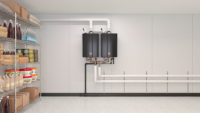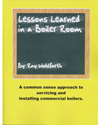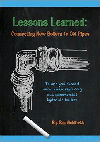DOE's New Boiler Efficiency Standards Under Fire
‘Regionalization’ issues inserted in energy bill could cost homeowners
The U.S. Department of Energy has increased the energy efficiency standards for residential boilers and furnaces. The final rule, published Nov. 19, is effective Jan. 18, 2008. It prescribes the following standard levels applicable to products manufactured on or after Nov. 19, 2015:
The standard levels in the final rule for nonweatherized gas furnaces, mobile home gas furnaces, oil-fired furnaces and oil-fired boilers are the same as the standard levels the DOE proposed in its Oct. 6, 2006, Notice of Proposed Rulemaking. However, the standard levels in the final rule for weatherized gas furnaces and gas boilers are less stringent than what DOE proposed. No changes were made to existing standards for steam boilers.
The Gas Appliance Manufacturers’ Association and other industry representatives sent comments to the Energy Department after the proposed rules were made public. The DOE had proposed an 83 percent AFUE minimum standard for weatherized gas furnaces and an 84 percent AFUE minimum standard for gas hot water boilers. GAMA cited safety issues with the DOE standards on these two types of products.
“Product safety and energy conservation are both important values for GAMA and the industries we represent,” GAMA noted in 2006. “However, where higher efficiency could compromise product safety, product safety must prevail.”
GAMA stated that the proposed 84 percent AFUE minimum standard for gas-fired boilers “presents serious consumer safety issues.” The safety issues were similar to those the group cited for weatherized gas furnaces.
“The lack of a venting system on weatherized (i.e., outdoor) furnaces does not eliminate all of the concerns of increased condensation associated with higher efficiencies for noncondensing furnaces. There is still the concern of heat exchanger failure.”
The DOE concluded that the health and safety concerns posed by an 83 percent AFUE level for weatherized furnaces “can be resolved by proper equipment and system design and proper installation.”
“While proper design issues are within the manufacturer’s control, DOE has not properly evaluated what ‘proper equipment and system design’ is required to mitigate the health and safety concerns,” GAMA stated. “Conversely, proper installation is often not within the manufacturer’s control.”
Those disappointed with the new standards find them “grossly inadequate.” “DOE has delivered a 'turkey' of an efficiency rule," reports Andrew deLaski, Executive Director of the Appliance Standards Awareness Project. “A 90% natural gas furnace efficiency standard would provide more than 17 times the carbon savings," said David B. Goldstein, Energy Program co-director of the Natural Resources Defense Council in a statement. The coalition also points out that 99 percent of natural gas furnaces currently sold already meet the new minimum efficiency level. “Our country cannot create a sustainable energy and climate future through incrementalism," stated Kateri Callahan, president of the Alliance to Save Energy. Roger Marran, president of heating system manufacturer Energy Kinetics, comments, “The minimum energy efficiency standard to take effect in 2015 increases the minimum AFUE rating for boilers. AFUE is a very misleading indicator of efficiency, and there has been very little progress toward implementing a modern standard. In fact, the independent study just released from Brookhaven National Laboratories, “The Performance of Integrated Hydronic Heating Systems,” shows why boilers with the same Energy Guide or AFUE rating can have very different annual efficiencies in the same applications. Boilers are very often used to produce domestic hot water, and because there is no federally prescribed standard for combined heat and hot water systems, AFUE is typically used instead. We see heating systems with very similar energy guide ratings installed in very similar homes that have very different annual fuel bills. This study shows some of the reasons why a heat and hot water system with an 87.5% AFUE will use less fuel than a 95% AFUE model, and similarly why an 88% efficiency rating vs. an 80% efficiency rating can save over 30%, instead of about 10%.” One very important indicator of high efficiency is low idle loss, or how much heat is wasted when the boiler is off. The AFUE or yellow energy guide rating is supposed to indicate average usage, but is generations behind today’s technology and virtually ignores idle loss and advanced controls. Marran continues, “It’s remarkable that it’s taken two decades and an independent study to broaden awareness of the potential to save energy and cut fuel bills. Based on the AFUE rating, people may not choose to upgrade, when in reality they can dramatically cut fuel costs without sacrificing comfort. Most heating contractors do not know about this study and find the results quite surprising based on conventional thinking. Armed with the knowledge of this study, the heating industry and consumers can have a real impact in cutting fuel use and lowering fuel bills. Conservation is a powerful tool that provides an important role in developing a solution to today’s high energy costs and supply challenges.”
2007 Energy Bill
In January 2007, GAMA and the American Council for an Energy Efficient Economy presented consensus boiler minimum performance and design requirements to key congressional staff for inclusion in a comprehensive energy bill in the 110th Congress to establish new federal minimum efficiency standards for residential gas and oil boilers.“The boiler industry directed GAMA to take this action as an alternative to new residential boiler standards proposed by the U.S. Department of Energy that would compromise consumer safety,” said Jack W. Klimp, president of GAMA.
However, by the end of the year, there were serious problems with the portions of the energy bill that concern boiler standards. The House and Senate versions of the bill authorized the DOE to establish regional efficiency standards, but only for heating and cooling equipment.
An industry coalition - including the Plumbing, Heating, Cooling Contractors-National Association; the Heating, Airconditioning & Refrigeration Distributors International (HARDI); and the Air Conditioning Contractors of America - has tried since last May to educate lawmakers about the harm to millions of consumers that will result from the new regionalization strategy.
Under current law, all regulated consumer products - including heating and cooling equipment - are subject to national federal standards. The coalition noted that environmental advocates lobbied for a new strategy. Under the new law, homeowners who use gas furnaces, air-conditioning and other heating and cooling systems will face new regional standards that will result in higher costs and less consumer choice, the coalition asserted.
“Regionalizing heating and cooling efficiency standards would eliminate the largest markets for the most affordable equipment, causing immediate cost increases for those states whose standards might not even change at all,” according to Talbot Gee, vice president of HARDI. “Homeowners, increasingly on tight budgets and caught off-guard by sudden heating or cooling system failures, will have no choice but to repair and maintain older, less-efficient systems rather than replacing them with high-efficiency systems that they could no longer afford.”
At press time, the energy bill had passed the Senate and was on its way to the House; once passed in the House, the president is expected to sign it.
Looking for a reprint of this article?
From high-res PDFs to custom plaques, order your copy today!







